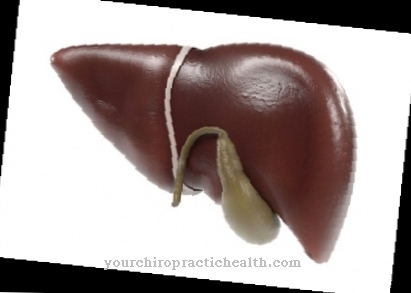The medical specialty of the Angiology is dedicated to diseases of the blood and lymph vessels. Circulatory disorders are particularly in focus.
What is Angiology

Angiology is the medical specialty that deals with diseases of the blood and lymph vessels. Phlebology only includes the veins and arteries and excludes the lymphatic vessels as a competence area.
According to the official classification, angiology is subordinate to internal medicine as a subfield. This "medicine of the vessels" takes care of the diagnosis, therapy and prophylaxis of arterial, venous and lymphatic malformations, acquired chronic syndromes and acute diseases.
There is some overlap with other branches of medicine. In this way, the angiologist can diagnose a vascular disease that the surgeon must operate on. The situation is similar with the problems of the coronary arteries, for which the cardiologist is primarily responsible. If the angiologist detects a pathological change in a vessel in the nervous system, he refers the patient to a neurologist.
When it comes to dermatology, there is an overlap when it comes to varicose veins. Sometimes the radiologist has to be on hand when there are questions about the evaluation of imaging procedures to be clarified. This colleague can also carry out further investigations.
Treatments & therapies
The angiologist is most frequently confronted with the consequences of arteriosclerosis in daily practice. Deposits in the blood vessels lead to narrowed areas in this widespread disease. Often the result is a "smoker's leg" or a diabetic foot. The resulting necrosis (tissue death) must be treated urgently. If these open wounds are located on the lower leg, the angiologist speaks of a "leg ulcer".
The group of functional vascular diseases includes thrombosis: a blood clot, medically a "thrombus", has formed and can completely close a blood vessel. The doctor then speaks of an "embolism". The post-thrombotic syndrome arises after deep-seated thrombosis and leads to a congestion of the reflux in the vascular system. An aneurysm is a widening of the artery wall that is thinned there and can burst. The result is internal bleeding. Cerebral arteries and the aorta (central main artery) or a coronary vessel are often affected.
The subject of angiology is also the varicose veins. The specialist distinguishes between primary (genetic) and secondary (acquired, e.g. due to tumor) varicosis. Raynaud's syndrome is pronounced when the fingers and toes are no longer adequately supplied with blood. Vascular spasms (cramps) of idiopathic (unknown) origin trigger the circulatory disorder. The blood vessels are enveloped by a layer of muscle that, like other muscles, can also develop phases of uncontrolled tension.
Erythromelalgia is a rare disease of functional vascular disorders. The vascular regulation disorder is associated with skin reddening and edema (swelling due to water retention). Often the angiologist cannot determine the cause. In the course of acrocyanosis, the fingers and toes are poorly supplied with oxygen. The cause is a reduced oxygen saturation of the hemoglobin. This is always a result of the mixing of arterial and venous blood through a pathological connection between arteries and veins (anastomosis).
The angiologist confronts problems of the lymph vessels in the form of lymphedema.Elephantiasis is associated with a breakdown of lymphatic structures in the legs, which causes such lymphedema to develop. Inflammatory diseases of the vessels are arteritis and lymphangitis, which result from blood poisoning.
Diagnosis & examination methods
In order to make a diagnosis, the angiologist will first take an anamnesis (medical history) and ask about symptoms. He then examines the patient, where he can determine changes in the skin and swellings. By palpating the blood vessels, the doctor assesses the pulse and thus the blood flow and blood vessel abnormalities. Often that is not enough and an angiography follows. This is a radiological procedure in which contrast media are used in most cases.
Sonography (ultrasound) is gentler on the patient. Doppler sonography registers the direction of blood flow, while color-coded Doppler sonography can differentiate between arterial and venous blood flow. This is important for the localization of circulatory disorders. Another special procedure is plethysmography, which is used to display fluctuations in volume. Light reflection rheography radiates infrared light into the examination area and measures the reflected light. The angiologist uses capillary microscopy to examine the finest vessels on the nail palatine.
Computed tomography (CT) is used to generate X-ray slice images of individual optical planes. In addition, the angiologist can use magnetic resonance imaging (MRI). An acute therapeutic intervention is balloon dilatation. The doctor penetrates a vessel with a catheter, at the end of which a small balloon can be inflated. In this way he removes constrictions in the vessel. This technique can also be used to insert a stent. The tubular stent receives the enlargement. The surgeon can surgically bridge constrictions by removing the body's own vessels. With injections of a concentrated saline solution the obliteration of varicose veins takes place.
Drug treatment is aimed at improving blood flow. The drugs commonly known as “blood thinners” have different mechanisms of action. Coumarin derivatives block vitamin K, which is involved in blood clotting. Heparin binds a number of other clotting factors in the blood. Platelet aggregation inhibitors prevent the blood platelets (thrombocytes) from joining together to form clumps. Platelets are specialized blood cells that only help blood to clot.
The angiologist prescribes antihypertensive drugs to lower blood pressure. In the case of vascular diseases, ACE inhibitors, which work on a hormonal basis, are particularly common. The patient must take water medication (diuretics) if he has edema. Infectious diseases of the vessels are treated with antibiotics. Conservative treatment methods of the angiologist are physiotherapeutic measures such as Kneipp treatments and lymph drainage, a massage technique. In addition, the doctor advises the patient to change their behavior. He should remain or become a non-smoker, eat moderately and exercise.

























.jpg)

.jpg)
